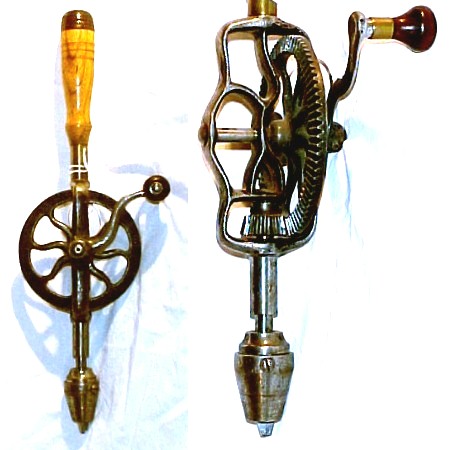Millers Falls No.2 Eggbeater
Drill Type Study
Go
back to
Main Study Page
Type Pre-L
From Roger K. Smith,
author
of PTAMPIA I & II. The main handle came from a
chisel. Both this drill and the one at right are distinguished by
having the early flat-faced main gear and the riveted crank knob
fastening.  |
From Sandy Moss: Came from a
Rhode Island cabinetmaker's estate auction; it was in the Bisson family
for 2 generations. Has unlined main handle. |
| This
type can be seen to follow Type L0 with its lined main handle, but to
predate Type L because it has the earlier smooth-faced
pattern of the main gear of the Type M but seventeen teeth on the
pinion
gear like the Type L and Type L0. Types M and L both have 78 teeth on
the main gear
like most of the LRRCW types. The Type
Pre-L
at left above has a different thrust bearing arrangement than any of
the earlier or later types,
but this wasn't much of an improvement, because the thrust bearing on
this
example is worn and has no provision for adjustment. The hemispherical
end of the spindle of the drill on the right bears directly on a socket
in the malleable iron frame with no provision for adjustment there,
either. The chucks are the same
as the Type L patented in 1877,
but only the example on the right can be read. These drills both
retain the set screw used to "lock" the main gear on its shaft;
this is
a rare condition indeed, as most other examples I have seen have some
sort of cross-drilled pin locking repair. Both examples here have the crank knob running on a two-piece shaft. The arrangement uses a wire shaft pressed into the crank; then the rosewood knob; then a flat washer; and finally, the end of the wire is peened to capture the washer and the knob. Later, Millers Falls introduced a one-piece fastening method for the knob that made use of a machined pin. |